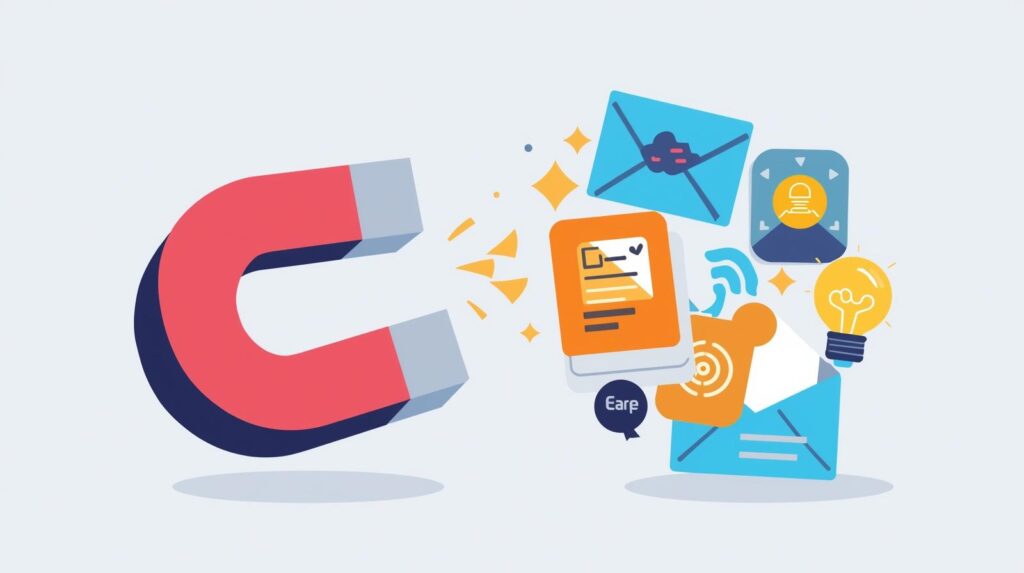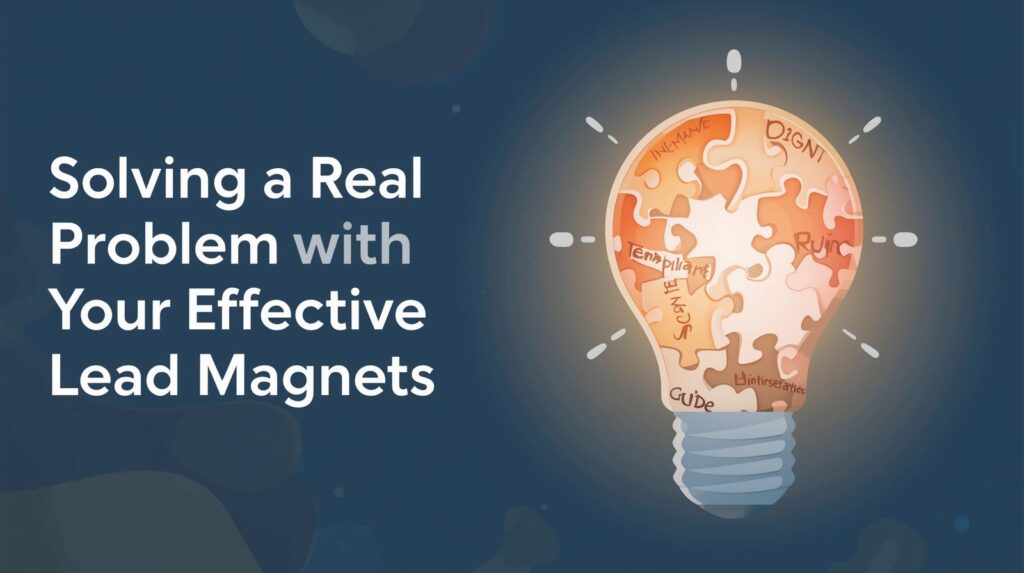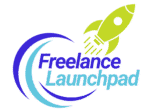The Freelance Frontier: Why Lead Magnets Are Your Secret Weapon
Starting a freelance business represents an exhilarating leap into entrepreneurship, yet for many, the initial challenge of consistently attracting clients can feel akin to navigating a dense minefield. New freelancers frequently grapple with the complexities of standing out in a crowded market, building credibility from scratch, and generating a steady stream of leads without the luxury of a hefty marketing budget or an extensive professional network.
This introductory phase can indeed be daunting, but a proven strategy exists that can transform this formidable challenge into a significant opportunity for growth and stability. At its core, a lead magnet is a valuable piece of content or a special offer provided to a target audience for free, in exchange for their contact information, most commonly an email address.
It functions as an “ethical bribe” or an “irresistible goodie” specifically designed to entice potential clients to take the very first step in engaging with a brand. The fundamental purpose of this strategic offering is to power a digital marketing lead generation strategy, capturing initial interest and initiating the crucial client acquisition process.
During this article, we will try to share examples of how you may go about creating a lead magnet for your own business. We will use our audience (you), and other freelancers looking for guidance as our example criteria, so you could see how we may approach this and in turn, you could use these ideas to spark your own ideas for creating useful lead generation content in your own niche.

Every beginner freelancer stands to benefit immensely from leveraging lead magnets. This approach offers several compelling advantages:
- Capturing Qualified Leads: Lead magnets prove remarkably effective for generating new leads because they offer immediate, tangible value without demanding a financial commitment. They act as a sophisticated filter, ensuring that contact details are gathered from individuals genuinely interested in the specific solutions offered, rather than merely casual browsers. This method represents a cost-effective, high-return investment in a long-term client acquisition strategy.
- Building Trust and Authority: By generously providing valuable, free content, a freelancer instantly positions themselves as an expert and a credible authority within their chosen niche. This positive first impression is absolutely vital for building brand awareness and fostering the foundation for enduring client relationships.
- Enabling Lead Nurturing: Once contact information is successfully captured, the lead magnet serves as the initial gateway into a sales funnel. This allows for the cultivation of relationships over time through automated, value-driven email sequences. This consistent, helpful communication gently guides prospects closer to becoming paying clients at a comfortable, unpressured pace.
The function of a lead magnet extends beyond simple data collection; it is fundamentally about initiating a relationship built on value. For a beginner freelancer, who may lack an extensive track record or an established reputation, this initial offering is paramount. It bypasses the need for immediate, deep trust in their paid services by providing a low-risk, high-reward interaction that demonstrates capability upfront. This approach fundamentally shifts the dynamic from potentially intrusive “cold outreach” to a welcoming, “value-first engagement.” This shift is absolutely critical for building a sustainable freelance business from the ground up in a highly competitive market.
Furthermore, a high-quality lead magnet functions as a tangible, actionable demonstration of a freelancer’s skills and unique value proposition. It serves as a miniature portfolio or a proof of concept. For new freelancers, who might not yet possess a robust collection of client testimonials, this allows them to show, rather than merely tell, what they can do and the kind of value they provide. This capability can significantly accelerate the trust-building process and pre-qualify leads who are already aligned with and appreciate the freelancer’s approach and quality of work.

– Steven Bartlett – Diary of a CEO
“Growth happens when you start doing the things you’re not qualified to do”.
Know Your North Star: Identifying Your Ideal Freelance Client
Before any brainstorming for lead magnet ideas can begin, a deep understanding of the intended audience is paramount. This is not merely a marketing cliché; it forms the absolute bedrock upon which every truly effective lead magnet is built. A successful lead magnet must be “specific to the audience’s pain points” and inherently “relevant” to their immediate needs. Without this clarity, marketing efforts are likely to miss their mark, leading to wasted time and resources.
To truly define this ideal client, a comprehensive approach is required, delving into various aspects of their profile:
- Demographics: This involves gathering basic statistical data that defines the target group, such as age, gender, income, education level, and geographic location. For instance, a freelancer might specifically target local businesses for in-person meetings or consider time zone differences for international clients to ensure practical collaboration.
- Psychographics: Moving beyond statistics, this involves exploring the psychological factors that shape an audience’s belief systems. This includes their values, morals, concerns (e.g., environmental impact), aspirations (e.g., career advancement, personal growth), lifestyle choices, and opinions. Understanding these nuances allows for a more profound connection, revealing what truly matters to them.
- Pain Points: This is arguably the most critical element. What specific problems, struggles, frustrations, or fears does the ideal client face that a freelancer’s services are uniquely positioned to solve? The lead magnet’s core function is to provide a “practical solution” to a “specific problem” they are actively experiencing.
- Aspirations/Goals: Beyond their current problems, what do ideal clients desire to achieve? What are their dreams, ambitions, and desired outcomes? The lead magnet should offer a tangible “quick win” that moves them a step closer to realizing that larger goal.
Practical methods for conducting this vital audience research include:
- Analyzing Existing Clients: If any clients have been served, even through small projects, it is beneficial to analyze what the best clients had in common. What industries were they in? What challenges did they bring? This provides valuable patterns.
- Conducting Market Research: Systematically investigate what the target audience is actively searching for online. Examine what competitors are offering as lead magnets and identify any gaps or underserved needs that could be addressed.
- Engaging Directly: The most direct route is to simply ask the audience. Utilize polls, surveys, or engage in direct conversations to understand what they find valuable. Review past client interactions or feedback for recurring themes and pain points.
- Monitoring Trends: Stay continuously updated with the latest trends and discussions within the industry and the target audience’s communities.
- Observing Online Behavior: Utilize analytics tools such as Google Analytics, LinkedIn insights, and social media data to understand their online habits, preferred content formats, and the platforms they frequent. Understanding where they “hang out online” and what kind of content they consume there is crucial.
The process of defining the target audience can be effectively structured around a “pain, dream, fix” framework. This concept directly reinforces the importance of solving a “specific problem” and offering “real value”. The “dream” aspect introduces a crucial emotional and aspirational layer, linking the immediate solution to a desired future state. This means a lead magnet is not merely about alleviating a problem; it is about enabling a positive transformation. For beginner freelancers, this framework provides an exceptionally powerful mental model for ideating lead magnets. Instead of simply considering “what freebie can be given away?”, the focus shifts to: “What specific challenge or frustration keeps my ideal client awake at night (pain)? What ideal future or desired outcome do they envision for themselves or their business (dream)? How can my freebie offer a small, tangible, and immediate step towards achieving that future (fix)?” This ensures the lead magnet is deeply resonant, addresses genuine needs, and is not just a generic offering, thereby attracting higher quality leads.
A common and costly pitfall for beginner freelancers is the temptation to try and serve everyone, which inevitably leads to diluted marketing efforts. The evidence strongly points to the strategic necessity of narrowing down the focus. Defining a niche first allows for more precise and efficient audience research, which in turn informs the creation of highly targeted and therefore more effective lead magnets. A general topic, while potentially casting a broader net, tends to attract lower quality leads who are less likely to convert into paying clients. This focused approach leads to significantly higher conversion rates, attracts more qualified leads, and ultimately saves valuable time and resources by avoiding wasted effort on uninterested prospects.

There’s a unique satisfaction in being the architect of your own career. You make the decisions, you set the direction, and you directly benefit from your hard work
Your Arsenal of Attraction: Effective Lead Magnet Ideas for Beginners
The most effective lead magnets consistently offer genuine value, directly address specific needs, and provide actionable insights or practical tools. For beginner freelancers, the key lies in choosing a format that is not only impactful for the audience but also relatively straightforward to create. These magnets should be easy to consume and deliver immediate gratification, providing a “quick win” that builds momentum and trust.
Checklists
Checklists are simple, actionable lists of steps or items that help an audience complete a specific process, stay organized, or achieve a particular goal. They excel at condensing complex knowledge into an easy-to-read, digestible format, offering immediate utility and a clear path forward. They are particularly effective when an audience needs guidance on an unfamiliar task or wants to ensure no crucial steps are overlooked.
Brainstorming ideas for freelancers:
- Client Onboarding Checklist: An essential tool for service providers to streamline the process of bringing on new clients, ensuring no steps are missed.
- Project Kick-off Checklist: Helps clients ensure all initial details, assets, and expectations are covered before a project begins.
- Pre-Pitch Checklist: Guides clients through the necessary steps to prepare a compelling and confident client pitch.
- Content Creation Workflow Checklist: Ideal for writers, content strategists, or social media managers, outlining a step-by-step process for efficient content production.
- Tax Prep Checklist: Addresses a common and often overwhelming pain point for many, providing a clear list of documents and actions needed for tax season.
Step-by-step creation guide:
- Identify a specific problem or goal: Pinpoint a task or process that the target audience frequently struggles with or finds overwhelming.
- Outline the steps: Break down the solution into clear, sequential, and actionable steps, focusing on what someone needs to do.
- Keep it concise: Checklists are most effective when they are brief, often just one or two pages, focusing on essential actions.
- Use simple language: Avoid jargon and write in a clear, straightforward manner that anyone can understand.
- Design for readability: Utilize bullet points, clear fonts, ample white space, and perhaps checkboxes for easy tracking.
- Add a brief introduction and conclusion: Start with a short explanation of the checklist’s purpose and how it will help, and end with a call to action or next steps.
- Save as PDF: This is a universal and easy-to-share format.
- Tools: Free tools like Google Docs, Canva (free/paid), Google Keep, Trello, Asana, and Evernote can be used for creation.
Pros and Cons of Checklists:
- Pros: Checklists are exceptionally easy and quick to create, making them ideal for beginners. They often achieve high conversion rates due to their immediate utility and straightforward nature. They effectively solve a very specific problem quickly, providing instant gratification.
- Cons: If not comprehensive or well-designed, they can have a low perceived value. They might be too basic for addressing truly complex, multi-faceted problems.
Templates
Templates provide pre-designed formats, frameworks, or pre-written content that save users significant time and effort on repetitive, complex, or design-heavy tasks. They enable users to achieve professional-looking results even without specialized skills.
Brainstorming ideas:
- Proposal Template: Empowers new users to create professional, persuasive proposals quickly, without starting from scratch.
- Social Media Content Calendar Template: Indispensable for social media managers or content creators to plan and schedule posts efficiently.
- Invoice Template or Contract Template: Essential legal and financial documents that every freelancer needs, provided in an easy-to-customize format.
- Client Brief Template: Streamlines the information-gathering process from clients, ensuring all necessary details are captured upfront.
- Website Wireframe Toolkit: A valuable resource for web designers to help clients visualize website layouts before development.
- Freelance Rate Calculator: A practical tool that directly addresses a common pain point for freelancers: determining appropriate and competitive pricing for their services.
Step-by-step creation guide:
- Identify a repetitive/time-consuming task: Consider what documents or designs ideal clients or fellow freelancers struggle to create from scratch, or what takes up a lot of their time.
- Build the framework: Create a basic, easy-to-use, and customizable structure for the document or design. This forms the core value.
- Provide clear instructions: Include guidance on how to customize and effectively use the template, making it adaptable to individual needs.
- Ensure versatility: Design the template to be flexible enough for various scenarios within its intended use.
- Brand it: Incorporate brand colors, fonts, and logo subtly to reinforce brand identity.
- Save as a versatile format: Offer it in formats like PDF, Google Docs, or a direct Canva template link, depending on the type of template.
- Tools: Canva (free/paid), Google Docs, Microsoft PowerPoint, or Keynote are excellent tools for creating various templates.
Pros and Cons of Templates:
- Pros: Templates offer high perceived value because they save the audience significant time and effort. They are an excellent way to demonstrate expertise and provide a tangible example of quality. They can be easily branded, reinforcing a professional image.
- Cons: Some templates can be highly niche-specific, limiting their broad appeal. Creating a truly effective and user-friendly template might require some initial design or structural skill. If the template is too generic or easily found elsewhere, it might not stand out.
Mini-Guides
Mini-guides (also known as short guides or short eBooks) are concise, focused educational resources that provide actionable insights on a specific topic. They are designed to deliver quick wins and establish expertise in a digestible format. They offer more depth than a checklist but are less overwhelming than a full-length eBook or course, striking a perfect balance for beginners.
Brainstorming ideas:
- 5 Steps to Your First Freelance Client: Directly addresses the core challenge and anxiety of new freelancers, providing a clear roadmap.
- Beginner’s Guide to Setting Freelance Rates: Solves a critical and common pricing dilemma, helping freelancers value their work appropriately.
- Quick Start Guide to Building Your Freelance Portfolio: Offers practical advice and steps for showcasing work effectively to attract clients.
- Cash Flow Crisis Survival Guide: Addresses financial pain points, providing actionable strategies for managing money as a freelancer.
- Guide to Optimizing Your LinkedIn Profile for Freelance Leads: Leverages a key professional platform to help freelancers attract inbound inquiries.
Step-by-step creation guide:
- Identify a single, focused topic: Choose one specific knowledge gap or burning question that the audience has, and commit to answering it thoroughly but concisely.
- Outline key sections/steps: Structure the content logically, breaking it into easy-to-follow sections or chapters.
- Draft concise, actionable content: Provide the essential information without unnecessary fluff or lengthy introductions. Aim for a practical length, typically 5-15 pages for written guides or a short video.
- Include actionable steps: Ensure that readers can immediately apply the information or insights provided.
- Add compelling visuals: Incorporate relevant images, diagrams, screenshots, or examples to enhance understanding and engagement.
- Design for readability: Use clear, professional fonts, distinct headings, and ample white space to make the guide easy on the eyes and simple to consume.
- Add a clear Call to Action (CTA): At the end, guide them to the logical next step, whether it is visiting a website, booking a consultation, or joining an email list.
- Save as PDF: This is the most common and accessible format for downloadable guides.
- Tools: Google Docs, Canva (free/paid), and Visme are excellent platforms for creating visually appealing mini-guides.
Pros and Cons of Mini-Guides:
- Pros: Mini-guides are highly effective at establishing expertise and building credibility with an audience. They provide valuable education that can genuinely help the audience. Content can often be repurposed from existing blog posts, videos, or course material, saving creation time. They are excellent for nurturing leads by providing deeper value.
- Cons: Compared to checklists or simple templates, mini-guides can be more time-consuming to create if not well-planned. There is a risk of overwhelming the audience if too much information is packed in, or if it is not sufficiently “mini”. If the content is generic or lacks unique perspectives, its perceived value might be low.
While checklists, templates, and mini-guides are ideal starting points due to their ease of creation and immediate impact, other effective lead magnet types exist. These include mini-courses , comprehensive resource lists or toolkits , free tools or calculators , or interactive quizzes. These can be excellent options for freelancers as they gain more experience, build a larger audience, and have more resources to invest in development.
The importance of “quick wins” cannot be overstated. Multiple sources consistently emphasize the significance of “immediate gratification” and delivering “quick wins”. Checklists, templates, and mini-guides are highlighted as particularly effective because they are “easy to read and understand” , “quick and simple to create” , and “save audiences time”. This is not merely a desirable feature; it is the fundamental benefit that resonates most powerfully with a beginner audience.
They are actively looking for actionable solutions that yield results fast. For beginner freelancers, whose time is often limited and who are actively seeking tangible progress and validation quickly, the “quick win” is a critical component of their lead magnet. This implies that overly complex or time-consuming lead magnets (such as a full-blown, multi-chapter eBook or an extensive course) might actually deter their specific target audience, even if they offer deep long-term value. The strategic focus should be on providing immediate, actionable solutions that build confidence and demonstrate competence.
Another strategic advantage for time-strapped beginner freelancers is the ability to repurpose content. Several sources explicitly mention leveraging existing content, such as blog posts, podcast episodes, or lessons from a coaching program, and transforming them into new lead magnet formats like eBooks, checklists, or guides. Some tools can even save “hours” by facilitating the transformation of existing posts into lead magnets without extensive re-writing or complex packaging. This clearly points to a significant efficiency trend in content creation. For beginner freelancers, this means they do not need to create entirely new, original content from scratch for their first lead magnet, which significantly reduces the barrier to entry and the initial time investment. This allows them to launch their lead generation efforts much faster, gaining momentum and valuable experience. Moreover, repurposing existing content helps ensure consistency in brand messaging and reinforces established expertise.
Table 1: Lead Magnet Ideas for Beginner Freelancers
| Lead Magnet Type | Freelancer Example | Solves This Problem | Quick Win You Get |
|---|---|---|---|
| ✅ Checklist | Client Onboarding Checklist | Messy, confusing client intake | A smooth, professional first impression |
| ✅ Checklist | Freelance Tax Prep Checklist | Stressful, unclear tax deadlines | Step-by-step clarity for staying compliant |
| 📑 Template | Freelance Proposal Template | Proposals look weak or unprofessional | Faster pitching + polished client-ready docs |
| 📑 Template | Social Media Content Calendar | Content feels random & inconsistent | Organized posting schedule you can stick to |
| 📘 Mini-Guide | 5 Steps to Your First Freelance Client | Struggling to land first paid work | A clear starter roadmap to your first client |
| 📘 Mini-Guide | Beginner’s Guide to Freelance Rates | Pricing fears, undervaluing skills | Confidence + a strategy for competitive rates |
Table 2: Checklist, Template, and Mini-Guide Comparison
| Lead Magnet | Best Use Case | Why It Works (Pros) | Watch Out (Cons) | Easy Tools to Create It |
|---|---|---|---|---|
| ✅ Checklist | Great for processes where steps matter (onboarding, tax, daily routines) | ⚡ Super quick to make. Converts well because it’s useful now. Immediate gratification | Might look “basic” if too generic. Won’t solve deeper problems | Google Docs, Canva, Trello, Asana |
| 📑 Template | Perfect for standard docs or repeatable tasks (proposals, calendars) | High perceived value. Saves tons of time. Shows off your expertise & brand | Can feel generic if not unique. Needs some design effort | Canva, Google Docs, MS PowerPoint/Keynote |
| 📘 Mini-Guide | Ideal for educational quick wins & building trust (pricing, getting clients) | Builds authority fast. Repurpose existing content. Great for ongoing lead nurture | Takes longer to create. If too long = overwhelm. If too shallow = low value | Google Docs, Canva, Visme |
“Sometimes, you just have to put in the work & learn as you Grow. Its the ultimate in free education!”
Martin Salter



Crafting Your Magnet: Best Practices for Creation and Design
The absolute cornerstone of any truly effective lead magnet is its ability to genuinely offer “real value” and provide a concrete “solution to a problem”. It must address a “single problem” rather than attempting to solve everything at once, ensuring it remains focused, highly relevant, and immediately useful. The content should be so exceptionally valuable that the reader genuinely feels they “would have paid money for that!”.
Effective lead magnets are inherently “quick and easy to digest” and presented in a “bite-sized” format. The goal is to avoid “fluff and filler” and get straight to the point, delivering immediate value without unnecessary preamble. Overwhelming an audience with too much information can lead to disengagement and drop-off, ultimately defeating the purpose of the lead magnet.
The visual design of a lead magnet significantly impacts its perceived value and, consequently, its engagement and conversion rates. It is crucial to use high-quality graphics, maintain consistent branding (incorporating brand colours and fonts), ensure excellent readability, and utilize ample white space to prevent a cluttered appearance. It is important to remember that a “free” resource does not have to look “free”—a professional aesthetic elevates its appeal. Tools like Canva can help even beginners achieve impressive, professional design results with ease.
This highlights a critical psychological principle: the perceived value of a free item can be significantly higher than its actual cost of creation, particularly if it is professionally presented, well-designed, and genuinely solves a problem. The visual and experiential quality signals the quality of the overall brand. For beginner freelancers, who may have limited resources, this means that strategically investing in the presentation and user experience of their lead magnet is as crucial as the content itself. A polished, professional freebie sets a high standard for their brand from the very first interaction, signaling quality, attention to detail, and a commitment to excellence.
This directly impacts the initial trust built with potential clients and significantly influences future conversion rates. It is about delivering a “premium free experience” that reflects the quality of their paid services.
A clear, concise, and compelling Call to Action (CTA) is absolutely crucial for guiding an audience to take the desired next step after consuming a lead magnet. Strong, action-oriented language should be used (e.g., “Download Your Guide Now,” “Register for the Workshop,” “Get Your Free Template”), clearly highlighting the benefits that will be received, and ensuring the CTA is visually prominent and stands out.
Once a prospect provides their contact information, the lead magnet must be delivered seamlessly and immediately, typically via an automated welcome email. The landing page where they opt-in should be clear, easy to navigate, and fully optimized for mobile devices, as many users will access it on their phones. The opt-in form itself should be as short as possible, asking for minimal information (ideally just an email address) to reduce any friction or conversion barriers. A well-designed thank-you page or a short video can further enhance the experience by guiding them on what to do next.
A well-crafted lead magnet does not just solve an immediate problem; it provides a miniature version of the experience of working with the freelancer or consuming their paid content. This means that lead magnets “lower the barrier to entry and give prospects a taste of what they can expect when they decide to do business with you”. If the lead magnet’s format aligns with the core paid offering (e.g., a mini-course as a preview of a full course), it “prepares subscribers for the student experience in the paid course”.
Furthermore, a lead magnet should address a problem that the paid offering tackles more comprehensively, and even raise questions that the paid offering then answers. This concept transcends merely providing “value” and moves into delivering “experiential value.” This strategic “taster menu” for services primes the lead for a deeper engagement, making the transition from freebie consumer to paying client feel natural and desirable

Avoiding the Landmines: Common Lead Magnet Mistakes to Sidestep
Even with the best intentions, freelancers can fall into common traps when creating lead magnets, hindering their effectiveness. Awareness of these pitfalls is the first step toward avoiding them.
A prevalent and costly mistake involves creating a lead magnet that fails to target the “right audience” or is designed too broadly. If a lead magnet does not directly align with the ideal customer’s specific pain points and interests, there is a risk of attracting “deal-seekers” or uninterested leads who are unlikely to ever convert into paying clients. This dilutes marketing efforts and wastes valuable time and resources.
A lead magnet must not only meet, but ideally “surpass” the expectations of those who download it. If the content is of “insufficient (or excessive) length and poor quality,” readers will feel “short-changed” for having provided their contact information. While it is not about showcasing everything known, it is about solving a specific problem quickly and effectively.
Overwhelming participants with too much information can lead to disengagement and drop-off, undermining the lead magnet’s purpose. This highlights a critical challenge: if the quality is poor, the content generic, or the offering fails to deliver on the implied promise, it creates a “value-expectation gap” that erodes trust. This emphasizes the need for consistency between the free offering and the paid service, building long-term relationships.
Integrity in delivery is paramount. A lead magnet must “promise and deliver on it”. It is crucial never to “bait and switch” by offering one thing and then delivering something else, or by signing people up for unwanted additional content. If the lead magnet fails to deliver on its initial promise, it leaves a “bad taste” in the prospect’s mouth and can severely damage the potential for a long-term relationship. While it should be genuinely helpful, it is also important not to give away the entire “core offering”; the goal is to leave them wanting more, not feeling like they have everything they need.
Even the most brilliantly crafted lead magnet will fail if no one knows it exists. A common pitfall is relying solely on organic social media posts without a strategic advertising campaign or a substantial existing following. Failing to promote a lead magnet across multiple relevant channels—including a website, blog posts, social media, and email—represents a significant missed opportunity for lead capture.
Crucially, a lead magnet is not a “one-off event”. Many businesses mistakenly expect immediate conversions and fail to nurture leads after the initial download. Without a structured, automated email follow-up plan, leads can quickly lose interest, and the valuable contact information acquired goes to waste. The lead magnet is merely the first step in a longer relationship-building journey. This reinforces the crucial role of post-download nurturing. The lead magnet serves as a “first step” or “gateway,” not the final conversion. This understanding guides freelancers to plan a complete customer journey, ensuring they leverage the acquired contact information effectively to move prospects further down the sales funnel.
Conclusions
For beginner freelancers embarking on the journey of building a new business, the strategic implementation of lead magnets is not merely an optional marketing tactic but an indispensable component of sustainable growth. The evidence consistently demonstrates that a well-conceived lead magnet serves as a powerful instrument for establishing credibility, attracting genuinely qualified leads, and initiating critical nurturing sequences that pave the way for long-term client relationships.
The core success of a lead magnet hinges on a profound understanding of the target audience, coupled with a commitment to delivering tangible, immediate value. The concept of the “ethical bribe” is particularly potent for new freelancers; by offering a low-risk, high-reward resource, they can proactively demonstrate their capabilities and build foundational trust before any financial commitment is requested. This initial interaction also functions as a “micro-experience” of their service quality, subtly showcasing their unique approach and professionalism.
In practical terms, beginner freelancers should prioritize lead magnet types that offer “quick wins” and are relatively straightforward to create, such as checklists, templates, and mini-guides. These formats are highly effective because they directly address immediate pain points, provide actionable solutions, and deliver instant gratification. Furthermore, leveraging existing content through repurposing can significantly reduce the time and effort required for creation, allowing for faster deployment and momentum building.
Beyond content, the presentation and delivery of a lead magnet are equally vital. A professional, eye-catching design elevates its perceived value, signaling a commitment to quality that reflects positively on the freelancer’s overall brand. Seamless delivery through optimized landing pages and automated email sequences ensures a positive user experience, minimizing friction and fostering continued engagement.
Finally, the journey does not end with a download. A common pitfall is treating the lead magnet as a one-off event. Instead, it must be viewed as the critical first step in a carefully planned customer journey. Consistent, value-driven follow-up communication is essential for nurturing leads, converting interest into sustained engagement, and ultimately, transforming prospects into loyal, paying clients. By focusing on these principles—deep audience understanding, value-first creation, professional execution, and diligent follow-up—beginner freelancers can navigate the complexities of client acquisition with greater confidence and build a robust foundation for their burgeoning businesses.
Your First Steps to Freelance Freedom
